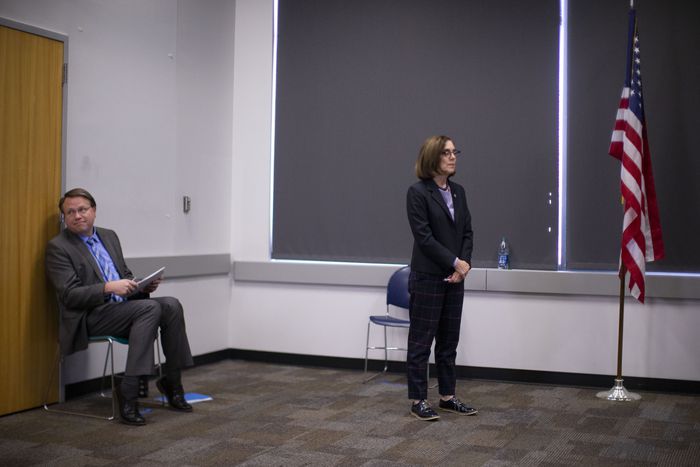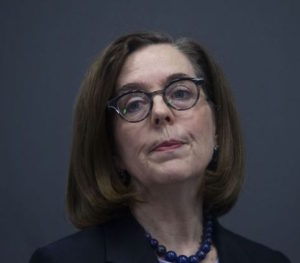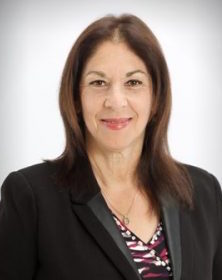
By DICK HUGHES/Oregon Capital Bureau
Oregon school buildings are closed for the rest of the academic year.
Schooling will continue through online courses, video chats and other forms of distance learning. Seniors who were on track to graduate before the state initially closed schools last month will receive passing grades and are assured of graduation.
Gov. Kate Brown made the announcements Wednesday afternoon.
“It is impossible to adhere to social distancing measures in our classrooms and in our schools,” she said. She added that Oregon’s education workforce is typically older and potentially more vulnerable to COVID-19.

“Every state in the country is struggling with these decisions,” she said. “I know this is certainly not what any of us were hoping for, but it is truly the best decision for our system.”
Washington Gov. Jay Inslee had already cancelled classes in his state for the rest of the school year.
Brown also addressed the state’s $1 billion a year Student Success Act funds, noting that many districts were ramping up to hire more staff with those funds. “We have directed school districts to put those plans on ice,” Brown said.
The Lincoln County School District had been anticipating $4.5 million from that initiative to fund everything from middle school sports to summer school to hiring more counselors, nurses and classroom aides.
As part of her directive, Brown also ordered Oregon’s public colleges to also extend their classroom shutdown through June. The governor said incoming students already accepted to Oregon’s public colleges and universities before she ordered public schools to close are guaranteed admission this fall regardless of how they do in the final months of their high school career.
Lincoln County schools react
Lincoln County School District Superintendent Karen Gray, in a series of emails to the school community, praised students and their families for their patience and said seniors with enough credit to graduate are finished. Seniors still needing credits have until the end of August to complete course work.

“To say that the last few months of high school for the Class of 2020 has been anything but normal is an understatement,” Gray said. “It has been met with changing deadlines, uncertain requirements, anticipation of announcements, and for many, a sense of loss. The students, staff, families and friends of our seniors have been patient, and we appreciate all of you for your grace through this time of uncertainty.”
Gray said that teachers and counselors will still help seniors with college plans, financial aid forms, and scholarship applications.
“We will contact every senior and make a post secondary plan with them and assist them to get where they want to be,” Gray said.
“We also have every intention to celebrate a formal graduation with as many of you as possible when restrictions are lifted and we can gather again,” Gray said.
The district is implementing its supplemental learning program, including distribution of 1,200 computer tablets to students who needed them, starting Monday for middle and high school students and April 20 for elementary students. The district has 5,500 students stretching from Yachats in the south to Otis in the north.
It will also continue offering meals – breakfasts, lunches and some dinners – every weekday. It has averaged 2,680 meals a day since mid-March.
“We will persevere and continue to do what is best for kids to the very best of our ability,” Gray said in a notice posted on the district’s website.
Union, school boards group endorse closure
The Oregon Education Association, which is the state’s largest teacher union, and the Oregon School Boards Association praised Brown’s decision, which had been expected. Districts are to continue paying employees.
During the press conference, Brown said she had no timeline for reopening closed businesses or relaxing other social distancing measures. She also said schools should hold off on hiring new employees envisioned through last year’s Student Success Act and its new tax on businesses.
Brown called on the state’s 197 school districts to focus on seniors who were not meeting graduation requirements when schools closed. Districts are to create personalized graduation and transition plans for each senior and help them proceed with college, job training, military service or other goals.

Colt Gill, who heads the state Department of Education, said this approach frees up seniors’ teachers, school counselors and administrators to ensure they seek out every student who was failing a required course and help them earn the needed graduation credits.
If seniors have met the graduation threshold and do not need continued study, their schooling might be done. Their version of distance learning is up to them and their district. “If districts want to keep seniors fully engaged in coursework, they can,” Marc Siegel, the department’s communications director, said later.
Gill said it’s up to individual districts to decide whether to extend school into the summer. Some might also choose to start the 2020-21 school year early. Seniors have until Aug. 31 to complete graduation requirements for the class of 2020 through a variety of means.
Sports and other state championships are canceled. Districts are encouraged to create alternatives to in-person proms, senior trips, commencement and other milestone events, or to reschedule them for when social distancing can be lifted.
“Think of creative ways to celebrate this class,” Gill said. “This is a class that we know are developing a lot of resilience right now, and we believe they’re ready for their next steps in life.”
Last week, the Department of Education instructed districts to contact students, ensure they were physically safe and healthy, address any behavioral health issues and then deal with learning. Next week, districts are to provide instruction in earnest.
“This does look different across the entire state,” Gill said Wednesday. “I want to be clear that distance learning is not synonymous with online learning, although it is online learning in some cases.”
Examples he gave included teachers working with a group of students through a video or audio conference, having one-on-one calls with students and posting a YouTube video of a teaching session.
“We have places in Eastern Oregon where they don’t have great internet connections where our school buses are delivering learning packets to students, and they’re bringing those back to the teachers and getting evaluative feedback on those,” Gill said.
Oregon’s recommendations mirror those in Washington, California, Kansas, Utah and other states, he said. The Department of Education has posted resources for educators and families, including a sample daily schedule for distance learning.
“It’s a heavy lift. It’s a heavy lift for the educators. It’s a heavy lift for our parents, as well,” Gill said.


